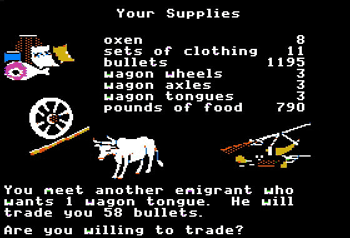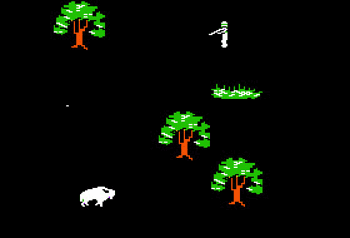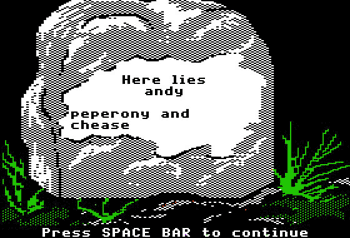
DEPARTMENTS  |
FEBRUARY 2006 – NO. 3 |
|
|
Computer Science
During the late '80s and early '90s, school children were sent into the frontier wilds of America, gun in hand, ready to take down rabbit, deer, and even buffalo. Teachers never blinked an eye; they actually scheduled class time to do it.
This school-sponsored marksmanship didn't take place in the 1800s — this was the 1900s. And it took place inside the schools. Equal parts adventure and strategy, the educational computer game Oregon Trail was designed to teach school children about the realities of 19th century pioneer life on the famed trek westward. The simple concept of taking your family (and friends) on a covered wagon from Independence, Missouri to the Beaver State was complicated by the seemingly endless array of options available to the player. Would you choose to play as a banker, a carpenter, or a farmer? How many yokes of oxen should you buy? Do you bring extra wagon axles? Which month should you set off from Independence? Should food rations be meager, adequate, or filling? When little Timmy broke his leg, was it best to rest a few days or to push on?

For one hour a week, school children across the country were confronted with these questions; and refreshingly, any answer could be the correct answer. There were no points taken off for caulking the wagon and not fording the river. There was no "right" pace to set on the trail. You could hunt as much as you wished without once having to show your work. Should all members of your party die, you weren't sent to the principle's office. School time spent traversing the Oregon Trail was equatable to a supervised recess.
The true beauty of Oregon Trail lay in its faux-educational packaging. Children knew right away that Oregon Trail was about as educational as Pac-Man, but they kept that insight to themselves. Asked if they were learning anything, children were quick to point out the educational aspects of the game. "It's 300 miles from Daly City to the Two Moon Junction;" "Snake bites are dangerous;" "There are two oxen per yoke." It was a struggle to keep from showing too much enjoyment while playing the game, lest educators catch on and turn the lesson plan back to typing or pop quizzes about the difference between "RAM" and "ROM."
It dawns on me now that during the early days of computer class the teachers were probably just as confused as the children about what they were supposed to do. Computers were hardly commonplace and I'd bet that most computer teachers at the time knew less about computers than any grandparent does now. My teacher, for example, was a minor league soccer player whose main scholastic interest in us had more to do with kicking and dribbling than typing and clicking. Aside from teaching a few basic computer terms and conducting typing lessons, what was a new computer teacher to do?
Into this educational breach came Oregon Trail, a "game" that marketed education as its primary goal. To educators, this marriage of historical education and unqualified fun represented the future of computing. "Let's trick these kids into learning something by making it a game!" To kids, this marriage of quickly forgotten information and barely concealed fun represented the apex of their educational careers.

The most surprising aspect of the game is how well it still holds up. Since the first Oregon Trail, numerous fancier versions have been created and sold. But it's still the bare bones original that provides the most robust experience, both in terms of game play and, obviously, nostalgia. Newer versions of the game tried to add too much education to the game, or inserted pretty, but ultimately superfluous, graphics. What's amusing about playing Oregon Trail a decade after you last touched it is how you still play the game exactly the same way as you did years ago.
You still go overboard buying supplies, you still spend most of your time hunting, you still hold your breath every time a family member gets sick. Your palms still get sweaty as you cross a particularly deep river. You still gleefully put in the names of two friends and an "enemy" to accompany you on your trip — and hope that should anyone die, it'll be him. All of the little tricks and personal tics that you utilized in middle school come flooding back as you start your journey. The Oregon Trail may have once been a hazardous journey to a promised land, but now it's become a direct route to memory lane.
There's always only been one true way to traverse the computerized Oregon Trail: keep hitting the space bar, skip over the educational text, and head for the Columbia River at a breakneck pace. So damn the scurvy, bring lots of bullets, and after you finally reach Oregon, you can begin traveling the world in search of that elusive thief … Carmen Sandiego.

